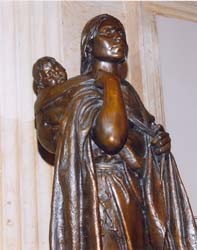 |
|||
|
Thank you for visiting my Senate Web site. One of the most important parts of my job as Senator is to help provide services and information to my constituents in North Dakota.
I hope you find this Web site both useful and interesting.
Senator Conrad spends a great deal of time traveling across North Dakota meeting constituents. Click here to see what he's doing in your area.
|
North Dakota
Lewis
and Clark and the Discovery of Americas West
Dear friend,
In May 1804, two men began an expedition that would change the course of history. Captains Meriwether Lewis and William Clark had been tasked by President Thomas Jefferson to explore the uncharted lands of the newly acquired Louisiana Territory. With an expeditionary party of close to four-dozen men, known as the “Corps of Discovery,” Lewis and Clark set out from Camp Dubois near St. Louis and began to make their trip westward. It was a journey that no one had ventured before. And North Dakota was about to gain its own chapter in one of our nations greatest adventure stories. In the late fall of 1804, Lewis and Clark made their way up the Missouri River into what is now central North Dakota. As winter descended across the plains the Corps of Discovery made camp near what is now Bismarck and began construction on a fort just outside the Indian villages of the Mandan and Hidatsa tribes. It is here, at Fort Mandan, that the expedition spent the longest leg of its journey, working for more than five months to prepare for their trip to the Pacific Ocean. While at Fort Mandan, Lewis and Clark became friends with a French Canadian fur trapper and his young Indian wife, Sakakawea. Lewis and Clark recruited the couple to serve as interpreters for their expedition. When spring came, the permanent party of the Corps of Discovery set out from the upper Missouri led by Sakakawea who carried on her back not only her infant son but also the lives of the many men on the expedition. Sakakawea proved to be incredibly valuable to Lewis and Clark as they traveled west. She served as an interpreter, guide and, at times, a negotiator leading the expedition through the territories of many Indian tribes. In fact, Clark called her his “pilot” and later credited her with the success of the expedition. This young Indian woman from North Dakota marked the path of discovery for Lewis and Clark and helped shape our country, as we know it today. I also encourage your to learn more about the Lewis and Clark Legacy Trail Project. This network of recreational trails along the Missouri River will allow people to walk where Lewis and Clark walked, and see what Lewis and Clark saw. Best of all, these hiking, biking and sightseeing trails will showcase our states natural beauty and create a lasting treasure that North Dakotans will enjoy for years to come. So welcome and let the adventure begin.
KENT CONRAD |
||


